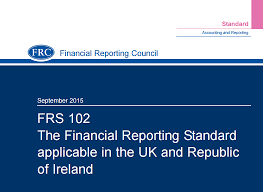
FRS 102 and FRS 105 Compared
Below we compare the differences between FRS 102 (focusing on ‘small’ entities) and FRS 105 (‘micro’ entities) along with some other factors to consider when deciding whether to prepare accounts using the ‘small’ or ‘micro’-entities regime. The ‘small’ and ‘micro’ entities regime thresholds have changed recently. See our separate blog here about these changes.
An entity entitled to and choosing to apply the ‘micro-entities’ regime must apply FRS 105 The Financial Reporting Standard applicable to the Micro-entities Regime. The micro-entities regime is optional and therefore, when preparing their financial statements, entities may wish to consider the differences between applying FRS 102 The Financial Reporting Standard applicable in the UK and Republic of Ireland and FRS 105 when deciding on the most suitable regime. The links given here are to the January 2022 versions of FRS 102/105.
New editions of both standards are expected to be published in the summer of 2024, effective for accounting periods commencing on/after 1 January 2026.
Users of the accounts
The most important aspect to consider is the needs of users. Different stakeholders will have different expectations. For example:
- Suppliers/trade creditors
- Banks and
- Credit rating agencies may require more information than is provided by micro-entity accounts.
The level of information required by FRS 105 is very limited when compared to other standards, so be careful to advise your client about the implications for making a good impression on such stakeholders where that might be important.
Future growth plans
An entity that is entitled to either the ‘small’ or ‘micro-entities’ regime but is close to the size limits should consider carefully any decision on which regime to adopt. This is particularly relevant for a micro-entity if the business is expected to grow to the extent that it will be necessary to switch to the small entities’ regime in the near future. Transition from FRS 105 to FRS 102 Section 1A will involve significant changes to the presentation of the accounts and the accounting policies applied (see below).
Accounting Differences Between FRS 102 and FRS 105
Outlined below are eleven of the key accounting differences between FRS 102 and FRS 102:
|
TOPIC |
FRS 102 |
FRS 105 |
| Revenue Recognition | Section 23 completely revised (in the changes published in March 2024) to include a simplified version of the IFRS 15 Five Step Model effective for accounting periods starting 1 January 2026 with early adoption allowed from 1 January 2024.
See our July 2024 webinar on these changes called ‘The Main Changes in Irish GAAP’. |
Section 20 revised in a similar fashion to FRS 102 (in the changes published in March 2024) with the simplified version of the IFRS 15 Five Step Model introduced effective for accounting periods starting 1 January 2026 with early adoption allowed from 1 January 2024. |
| Leasing | Section 20 is completely revised with the introduction of rules similar to those in IFRS 16, where almost all leases will go on balance sheet, and only certain types of operating lease will remain off balance sheet.
These changes are effective for accounting periods starting 1 January 2026 with early adoption allowed from 1 January 2024. |
No change to the previous regime of only capitalizing finance leases. All operating leases remain as they were before.
See our July 2024 webinar on these changes called ‘The Main Changes in Irish GAAP’. |
| Investment properties | With the exception of investment property rented to another group entity, a revaluation each year is required, with changes recognised in profit or loss. | Measured at cost less depreciation and impairment. |
| Property plant and equipment | Measured at cost less depreciation and impairment but can choose to adopt a revaluation accounting policy for fixed assets of the same class | Measured at cost less depreciation and impairment. |
| Intangible assets | Measured at cost less amortisation and impairment but can choose in limited circumstances to adopt a revaluation accounting policy for intangible assets of the same class | Measured at cost less amortisation and impairment. |
| Development costs and borrowing costs | These costs can, subject to certain conditions, be capitalised. | No option to capitalise. Must be expensed to the profit and loss account in the period in which they are incurred. |
| Trade and asset acquisition | An intangible asset purchased with a business is normally recognised as an asset when separable and arises from a contractual or other legal basis | An intangible asset purchased with a business must not be recognised separately from goodwill. |
| Financial instruments | Financial instruments are divided into ‘basic’ and ‘other’ instruments.
The former are mostly measured at amortised cost, the latter mostly at fair value with movements generally recognised in profit or loss.
Entities can instead choose to apply the recognition and measurement requirements of IAS 39 Financial Instruments: Recognition and Measurement and/or IFRS 9.
The exception is directors’ loans which may be measured initially at transaction price. |
No distinction between ‘basic’ and ‘other’ with all financial instruments initially recognised at cost, which will be the transaction price. Subsequent revaluation or measurement of financial instruments at fair value not permitted.
For lending arrangements, simplifications are made in relation to the allocation of interest and transaction costs, and no requirement to calculate an effective interest rate. Also, there is no requirement to impute a market rate of interest in arrangements conducted at non-market rates. |
| Equity-settled share-based payments | Recognised at the fair value of the goods or services when received. For arrangements with employees, fair value is measured at the grant date and the expense recognised over the vesting period. | Not recognised in the accounts until the shares are issued.
|
| Foreign exchange forward contract | Recognised on the balance sheet as a financial instrument at fair value and the associated debtor or creditor retranslated at the year-end rate. Hedge accounting can be applied in certain circumstances. | When a trading transaction is covered by a related or matching forward contract, the requirement is to use the rate specified in the contract.
If not matched to a trading transaction the cost of the foreign exchange forward contract will be recognised as a financial asset, unless it is not material in which case it will be recognised immediately as an expense in profit or loss. |
| Defined benefit pension plans | Net interest on the net defined benefit asset or liability is recognised in the profit and loss account, and is calculated with reference to high quality corporate bonds i.e., the same rate is applied to both the plan assets and liabilities. | Recognition of the surplus or deficit of the plan on the balance sheet not permitted. Agreed funding of deficit must, however, be recognised as a liability. Contributions payable to the plan accounted for as an expense. |
| Government grants | Government grants can be accounted for using either the performance model or the accruals model. | Requirement to use the accruals model.
|
| Deferred tax | Based on timing differences | No deferred tax |
Please see our latest CPD Webinar on The Main Changes in Irish GAAP (recorded July 2024).
See our webinar entitled ‘The Main Changes in Irish GAAP’ on the latest changes to FRS 102 here.
For more on the whole ISQM process for audit firms, please see our ISQM 1 Toolkit on our website here.
Please go to our website to see our:
- Anti-Money Laundering Policies Controls and Procedures Manual (March 2022) — View the table of contents
- AML Webinar (December 2023) available here, which accompanies the AML Manual. It explains the latest legal AML reporting position for accountancy firms and includes a quiz. Upon completion you receive a CPD certificate for attendance in your inbox.
- Letters of engagement and similar templates—Please visit our website here where immediate downloads are available in Word format. A bulk discount is available for orders of five or more items bought together.
- ISQM TOOLKIT, or if you prefer to chat through the different audit risks and potential appropriate responses presented by this new standard, please contact John McCarthy FCA by email at john@jmcc.ie.
- We typically tailor ISQM training and brainstorming sessions to suit your firm’s unique requirements. The ISQM TOOLKIT 2022 is available to purchase here.







